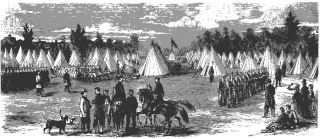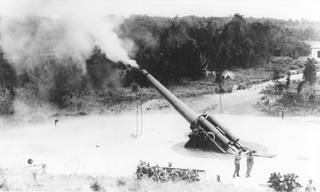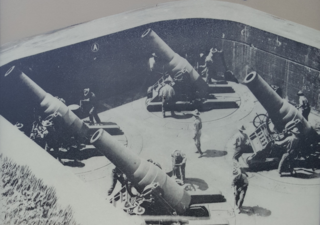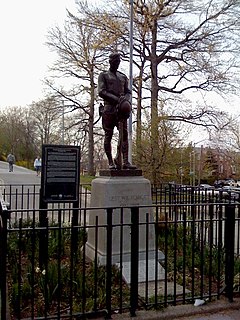 W
WThe 11th Regiment New York Volunteer Infantry was an infantry regiment of the Union Army in the early years of the American Civil War. The regiment was organized in New York City in May 1861 as a Zouave regiment, known for its unusual dress and drill style, by Colonel Elmer E. Ellsworth, a personal friend of U.S. President Abraham Lincoln. Drawn from the ranks of the city's many volunteer fire companies, the unit was known alternately as the Ellsworth Zouaves, First Fire Zouaves, First Regiment New York Zouaves, and U.S. National Guards.
 W
WThe 14th Regiment New York State Militia was a volunteer militia regiment from the City of Brooklyn, New York. It is primarily known for its service in the American Civil War from April 1861 to May 6, 1864, although it later served in the Spanish–American War and World War I.
 W
WThe 69th Infantry Regiment is an infantry regiment of the United States Army. It is from New York City, part of the New York Army National Guard. It is known as the "Fighting Sixty-Ninth", a name said to have been given by Robert E. Lee during the Civil War. An Irish heritage unit, as the citation from poet Joyce Kilmer illustrates, this unit is also nicknamed the "Fighting Irish", immortalized in Joyce Kilmer's poem When the 69th Comes Home. Between 1917 and 1992 it was also designated as the 165th Infantry Regiment. It is headquartered at the 69th Regiment Armory in Manhattan.
 W
WThe 70th New York Volunteer Infantry Regiment was one of five infantry regiments formed by former U.S. Congressman Daniel Sickles and established as part of the Excelsior Brigade which fought with the Union Army during multiple key engagements of the American Civil War, including the Chancellorsville, Gettysburg and Overland campaigns. Leaders from the 70th New York recruited men from New Jersey, as well as from cities and small towns across the State of New York.
 W
WThe 73rd New York Volunteer Infantry Regiment was an infantry regiment of Union Army in the American Civil War. The regiment was organized in New York City in May 1861, originally under the designation the Fourth Excelsior Regiment, as a Zouave regiment, known for its unusual dress and drill style. The uniform worn by this regiment consisted of a dark blue chasseur jacket with light blue trim and light blue trefoils on each sleeve, sky blue chasseur trousers with two white stripes down each leg, brown leather gaiters, a light blue kepi with a dark blue band and dark blue piping, and a red Zouave fez with a blue tassel as a fatigue cap. Drawn from the ranks of the city's many volunteer fire companies, the unit was known alternately as the Second Fire Zouaves, after the 11th New York was known as the First Fire Zouaves, and they were also known as the Excelsior Zouaves. Some of the men wore the brass letters "E Z" on the bands of their kepis. Many artists have depicted this regiment also with red shirts with the collar sticking out over the jacket creating a "red collar."
 W
WThe 74th Regiment New York Volunteer Infantry was a Union regiment recruited in 1861, during the American Civil War. The regiment was part of Sickles' Excelsior Brigade and their first commander was sailor and engineer Col. Charles K. Graham. The regiment participated in the Peninsula Campaign of 1862 and was particularly noted for its part at the Battle of Williamsburg. It was also present at the battles of Fredericksburg, Chancellorsville, Gettysburg and the Overland Campaign.
 W
WThe 245th Coast Artillery Regiment was a Coast Artillery Corps regiment in the New York National Guard. It garrisoned the Harbor Defenses of New York, New York and predecessor commands 1924–1944.
 W
WThe 369th Infantry Regiment, formerly known as the 15th New York National Guard Regiment and commonly referred to as the Harlem Hellfighters, was an infantry regiment of the New York Army National Guard during World War I and World War II. The Regiment consisted mainly of African Americans, though it also included several Puerto Rican Americans during World War II. With the 370th Infantry Regiment, it was known for being one of the first African American regiments to serve with the American Expeditionary Forces during World War I.
 W
WBattery Kingman is an artillery emplacement at Fort Hancock, New Jersey. The Battery was named after Dan Christie Kingman an officer in the United States Army who served as Chief of Engineers from 1913 to 1916.
 W
WThe Battle of Long Island, also known as the Battle of Brooklyn and the Battle of Brooklyn Heights, was a military action of the American Revolutionary War fought on August 27, 1776, at the western edge of Long Island in the present-day borough of Brooklyn, New York. The British defeated the Americans and gained control of the strategically important Port of New York, which they held for the rest of the war. It was the first major battle to take place after the United States declared its independence on July 4, and in troop deployment and combat, it was the largest battle of the entire war.
 W
WThe Dead Rabbits riot was a two-day civil disturbance in New York City evolving from what was originally a small-scale street fight between members of the Dead Rabbits and the Bowery Boys into a citywide gang war, which occurred July 4–5, 1857. Taking advantage of the disorganized state of the city's police force—brought about by the conflict between the Municipal and Metropolitan police—the fighting spiraled into widespread looting and damage of property by gangsters and other criminals from all parts of the city. It is estimated that between 800 and 1,000 gang members took part in the riots, along with several hundred others who used the disturbance to loot the Bowery area. It was the largest disturbance since the Astor Place Riot in 1849 and the biggest scene of gang violence until the New York Draft Riots of 1863. Order was restored by the New York State Militia, supported by detachments of city police, under Major-General Charles W. Sandford.
 W
WSS El Estero was a ship filled with ammunition that caught fire at dockside in New York Harbor in 1943, but was successfully moved away and sunk by the heroic efforts of tug boats and fireboats, averting a major disaster.
 W
WFort Hancock is a former United States Army fort at Sandy Hook in Middletown Township New Jersey. The coastal artillery base defended the Atlantic coast and the entrance to New York Harbor, with its first gun batteries operational in 1896. Between 1874 and 1919, the adjacent US Army Sandy Hook Proving Ground was operated in conjunction with Fort Hancock. It is now part of Fort Hancock Memorial Park. It was preceded by the Fort at Sandy Hook, built 1857–1867 and demolished beginning in 1885.
 W
WFort Slocum, New York was a US military post which occupied Davids Island in the western end of Long Island Sound in the city of New Rochelle, New York from 1867 to 1965. The fort was named for Major General Henry W. Slocum, a Union corps commander in the American Civil War.
 W
WFort Totten is a former active United States Army installation in the New York City borough of Queens. It is located on the Willets Point peninsula on the north shore of Long Island. Fort Totten is at the head of Little Neck Bay, where the East River widens to become Long Island Sound. While the U.S. Army Reserve continues to maintain a presence at the fort, the property is now owned by the City of New York.
 W
WFort Wadsworth is a former United States military installation on Staten Island in New York City, situated on The Narrows which divide New York Bay into Upper and Lower halves, a natural point for defense of the Upper Bay and Manhattan beyond. Prior to closing in 1994 it claimed to be the longest continually garrisoned military installation in the United States. It comprises several fortifications, including Fort Tompkins and Battery Weed and was given its present name in 1865 to honor Brigadier General James Wadsworth, who had been killed in the Battle of the Wilderness during the Civil War. Fort Wadsworth is now part of the Staten Island Unit of Gateway National Recreation Area, maintained by the National Park Service.
Fort Hamilton is a United States Army installation in the southwestern corner of the New York City borough of Brooklyn, surrounded by the communities of Bay Ridge and Dyker Heights. It is one of several posts that are part of the region which is headquartered by the Military District of Washington. Its mission is to provide the New York metropolitan area with military installation support for the Army National Guard and the United States Army Reserve. The original fort was completed in 1831, with major additions made in the 1870s and 1900s. However, all defenses except about half of the original fort have been demolished or buried.
 W
WThe Harbor Defenses of New York was a United States Army Coast Artillery Corps harbor defense command. It coordinated the coast defenses of New York City from 1895 to 1950, beginning with the Endicott program, some of which were located in New Jersey. These included both coast artillery forts and underwater minefields. The command originated circa 1895 as an Artillery District(s) and became the Coast Defenses of Eastern New York and Coast Defenses of Southern New York in 1913. Circa 1915 the Coast Defenses of Sandy Hook separated from the latter command. In 1925 the commands were renamed as Harbor Defense Commands, and in 1935 the Harbor Defenses of Eastern New York was almost entirely disarmed, although possibly retaining the minefield capability. The New York and Sandy Hook commands and the Harbor Defenses of Long Island Sound were unified as the Harbor Defenses of New York on 9 May 1942.
 W
WHMS Jersey was a 60-gun fourth rate ship of the line of the Royal Navy, built to the 1733 proposals of the 1719 Establishment of dimensions at Plymouth Dockyard, and launched on 14 June 1736. She is most noted for her service as a prison ship during the American Revolutionary War.
 W
WWithin the city-operated parks system of New York City, there are many parks that are either named after individuals who participated in the Vietnam War or contain monuments relating to the war.
 W
WWithin the city-operated parks system of New York City, there are many parks that are either named after individuals who participated in World War I or contain monuments relating to the war.
 W
WThe New York City draft riots, sometimes referred to as the Manhattan draft riots and known at the time as Draft Week, were violent disturbances in Lower Manhattan, widely regarded as the culmination of white working-class discontent with new laws passed by Congress that year to draft men to fight in the ongoing American Civil War. The riots remain the largest civil and most racially-charged urban disturbance in American history.
 W
WNew York City during the American Civil War (1861–1865) was a bustling American city that provided a major source of troops, supplies, equipment and financing for the Union Army. Powerful New York politicians and newspaper editors helped shape public opinion toward the war effort and the policies of President Abraham Lincoln. The port of New York, a major entry point for immigrants, served as recruiting grounds for the Army. Irish and Germans participated in the war at a high rate.
 W
WThe New York Port of Embarkation (NYPOE) was a United States Army command responsible for the movement of troops and supplies from the United States to overseas commands. The command had facilities in New York and New Jersey, roughly covering the extent of today's Port of New York and New Jersey, as well as ports in other cities as sub-ports under its direct command. During World War I, when it was originally known as the Hoboken Port of Embarkation with headquarters in seized Hamburg America Line facilities in Hoboken, New Jersey, the Quartermaster Corps had responsibility. The sub-ports were at Boston, Baltimore, Philadelphia and the Canadian ports of Halifax, Montreal and St. Johns. The World War I port of embarkation was disestablished, seized and requisitioned facilities returned or sold and operations consolidated at the new army terminal in Brooklyn. Between the wars reduced operations continued the core concepts of a port of embarkation and as the home port of Atlantic army ships. With war in Europe the army revived the formal New York Port of Embarkation command with the New York port, the only Atlantic port of embarkation, taking a lead in developing concepts for operations.
 W
WThe Old Guard of the City of New York is a veterans' organization and ceremonial unit in New York City. It was consolidated in 1868 when state legislation merged the predecessor organizations the New York Light Guard and the New York City Guard. Its longtime headquarters was at 307 W 91st St from 1920-2016, a historic building dating from 1896 by the architect Clarence True. The unit was known for its elaborate uniforms with bearskin caps, its participation at civic events, and its annual ball. The Old Guard Headquarters are now located at 285 West 246th Street, Bronx, NY 10471.
 W
WPelham Bay Naval Training Station was a WWI era US Navy training facility located in Pelham Bay Park's Rodman's Neck in the Bronx. Located near City Island, and Westchester county, it was operational from 1917 to 1919.
 W
WThe Rose and Crown Tavern was a farmhouse and tavern located in New Dorp, Staten Island.
 W
WSquadron A refers to the historic cavalry unit of New York City's Upper East Side.
 W
WU.S. Army General Hospital No. 1, also known as Columbia War Hospital, was a World War I era field hospital built by Columbia University on the Columbia Oval property in Norwood, The Bronx. The hospital was used as a medical training facility, a model for military field hospitals, and for long-term treatment of patients.
 W
WThe Veteran Corps of Artillery of the State of New York (VCASNY) is an American historic militia organization founded at the end of the American Revolutionary War for the purpose of preventing another British invasion of New York City.